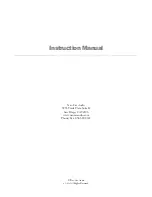
190-01878-02
GMA 342/345 Installation Manual
Rev. 5
Page 2-14
6. If a problem is encountered during the update process, follow the below steps for possible
solutions.
a) Use the Pilot Knob to power cycle the GMA 342/345, then perform the process again.
b) Attempt to re-download the GMA 342/345 software to the PC, recreating the loader SD
card, and perform the process again.
c) Recreate the loader card using the recommended Sandisk® brand 4GB SD card, and attempt
the update process again.
d) If still having difficulty performing the update, contact Garmin Aviation Technical support.
7. Once the update process is finished the GMA 342/345 will automatically reboot back into normal
operating mode.
8. The update card does not need to be removed after the update process and can be left in the
GMA 342/345 at the installer’s discretion.
Once the unit has been updated, verify the correct software version is installed (see
instructions). For the GMA 345 only, if a Bluetooth firmware update is included with the software update,
the Bluetooth firmware will be updated automatically after the GMA 345 reboots. While a Bluetooth
firmware update is being performed in the GMA 345, the Bluetooth annunciator will blink in an ON - ON
- OFF pattern for several minutes. When the Bluetooth software update is completed, the Bluetooth
functions will return to normal operation.
2.10 Electrical Noise
Because the audio panel is a point in the aircraft where signals from many pieces of equipment are brought
together, care must be taken to minimize effects from coupled interference and ground loops.
Coupled interference can sneak into audio system interconnecting cables when they are routed near large
AC electric fields, AC voltage sources, and pulse equipment (strobes, spark plugs, magnetos, EL displays,
CRTs, etc). Interference can also couple into audio system interconnecting cables by magnetic induction
when they are routed near large AC current-carrying conductors or switched DC equipment (heaters,
solenoids, fans, autopilot servos, etc).
Ground loops are created when there is more than one path in which return currents can flow, or when
signal returns share the same path as large currents from other equipment. These large currents create
differences in ground potential between the various equipment operating in the aircraft. These differences
in potential can produce an additive effect at an audio panel signal input.
The audio panel may "see" the desired input signal plus an unwanted component injected by ground
differentials, a common cause of alternator-related noise. This is the main reason why all audio jacks
should be isolated from ground. Terminating audio shields just at one end eliminates another potential
ground loop injection point.
Single-point grounding cannot be overstressed for the various avionics producing and processing audio
signals. Single-point, in this context, means that the various pieces of equipment share a single common
ground connection back to the airframe. Good aircraft electrical/charging system ground bonding is also
important.
The wiring diagrams and accompanying notes in this manual should be followed closely to minimize noise
effects.
















































